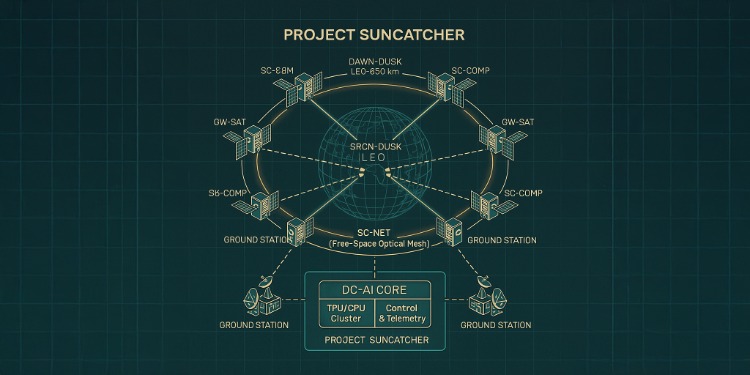Start your day with intelligence. Get The OODA Daily Pulse.
Start your day with intelligence. Get The OODA Daily Pulse.
Fast on the heels of our conversation with Maxie Reynolds at OODAcon 2025 in the session entitled “Data at the Edge: Subsea and Sustainable Next-Gen Datacenter“, Alphabet recently released the details of X Development’s Project Suncatcher – an audacious vision for scaling artificial intelligence (AI) infrastructure into orbit by coupling solar-powered satellites equipped with Tensor Processing Units (TPUs) and free-space optical networks.
The project envisions future constellations of networked satellites operating as machine learning data centers in space, harvesting the Sun’s abundant energy to power AI computation beyond terrestrial limits.
AI compute demand is growing exponentially, driving massive increases in energy consumption. Terrestrial data centers—already significant energy consumers—face limits due to cost, sustainability, and physical infrastructure constraints.
Project Suncatcher represents a paradigm shift: relocating computation to space, where solar exposure is continuous and energy capture can be up to eight times higher than on Earth.

For the full white paper on Project Suncatcher from Travis Beals, Senior Director, Google’s Paradigms of Intelligence, and his colleagues, see: Exploring a space-based, scalable AI infrastructure system design.
X Development LLC, formerly known as Google X, is Alphabet’s semi-autonomous “moonshot factory” — a research and innovation division dedicated to solving some of the world’s hardest problems through radical technological breakthroughs. Founded by Google co-founder Sergey Brin and led by Astro Teller (the self-styled Captain of Moonshots), X operates as an incubator within Alphabet Inc., distinct from Google LLC but often collaborating with its research and infrastructure teams.
Projects at X are characterized by three traits:
X’s past and current initiatives include Waymo (self-driving cars), Wing (drone delivery), Loon (stratospheric internet balloons), and Mineral (AI-powered agriculture). Once a project achieves technical and market viability, it may “graduate” from X into its own Alphabet company — a process known internally as graduation.
Project Suncatcher fits the X Development ethos: it is a “moonshot” exploring how to scale AI computation beyond Earth by combining orbital energy systems with machine learning infrastructure — an idea at the frontier of sustainability, compute, and space technology.
Subsea, Space, and AI Sovereign Power: A Future That Does Not Suffer from a Failure of Imagination: The global race to expand AI compute is pushing data centers underwater, into orbit, and adjacent to new energy sources — reshaping critical infrastructure and geopolitical risk.
Underwater and Orbital: The Next Frontier for Data Centers: This piece surveys subsea and orbital data-center concepts as emerging responses to land, cooling, and resiliency constraints. It frames these unconventional siting strategies as part of a broader shift toward energy- and environment-aware infrastructure for AI-era compute.
The Future of the Energy Sector and AI Data Centers: An analysis of how electricity availability, grid stability, and fuel choices now shape the feasibility and location of AI data centers. It highlights the tightening linkage between compute growth and long-horizon energy investments, including renewables and advanced nuclear.
Constraints to Growth Across Exponential Technologies: Outlines non-silicon bottlenecks—electric power, skilled trades, and large-scale infrastructure mobilization—that limit deployment speed across emerging technologies. For data centers, these constraints translate into extended timelines and higher execution risk.
The Commercial Convergence of AI Compute and Nuclear Technology: Discusses the growing commercial logic of pairing high-density AI compute with nuclear generation. It points to small modular reactors and novel procurement structures as potential pathways to off-grid or firm, low-carbon power.
The Climate Crisis, Texas’ Bitcoin Miners, and European Farmers: Explores how rising electricity demand from digital industries collides with climate impacts and competing sectoral needs. The piece foreshadows policy and market friction over power allocation as AI loads ramp.